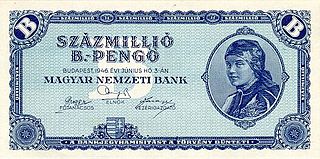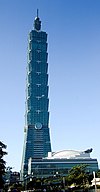
In economics, hyperinflation is a very high and typically accelerating inflation. It quickly erodes the real value of the local currency, as the prices of all goods increase. This causes people to minimize their holdings in that currency as they usually switch to more stable foreign currencies. Effective capital controls and currency substitution ("dollarization") are the orthodox solutions to ending short-term hyperinflation; however there are significant social and economic costs to these policies. Ineffective implementations of these solutions often exacerbate the situation. Many governments choose to attempt to solve structural issues without resorting to those solutions, with the goal of bringing inflation down slowly while minimizing social costs of further economic shocks.

The renminbi, also known as the Chinese yuan, is the official currency of the People's Republic of China. The renminbi is issued by the People's Bank of China, the monetary authority of China. It is the world's fifth-most-traded currency as of April 2022.

The Korean People's won, more commonly known as the North Korean won and sometimes known as the Democratic People's Republic of Korea won, is the official currency of North Korea. It is subdivided into 100 chon. The currency is issued by the Central Bank of the Democratic People's Republic of Korea, based in the North Korean capital city of Pyongyang.
The Hong Kong dollar is the official currency of Hong Kong. It is subdivided into 100 cents. Historically, it was also subdivided into 1000 mils. The Hong Kong Monetary Authority is the monetary authority of Hong Kong and the Hong Kong dollar.
The New Taiwan dollar is the official currency of the Republic of China. Usually, the $ sign precedes the amount, but NT$ is used to distinguish from other currencies named dollar. The New Taiwan dollar has been the currency of the island of Taiwan since 1949, when it replaced the old Taiwan dollar, at a rate of 40,000 old dollars per one new dollar. The base unit of the New Taiwan dollar is called a yuan (圓), subdivided into ten chiao (角) or 100 fen (分), although in practice neither chiao nor fen are used.

The Central Bank of the Republic of China (Taiwan), known from 1924 to 2007 as the Central Bank of China and still referred to under the acronym CBC, is the central bank of the Republic of China.

The Bank of Taiwan is a commercial bank headquartered in Taipei, Taiwan. It was established in 1897-1899 as a Japanese policy institution or "special bank", similarly as the Nippon Kangyo Bank, Hokkaido Takushoku Bank, Industrial Bank of Japan, and Bank of Chōsen. Its aim was to finance industrial demand in Japanese-ruled Taiwan and also to promote trade between South China, Southeast Asia and the Japanese possessions in the Pacific.

The Taiwanese yen was the currency of Japanese Taiwan from 1895 to 1946. It was on a par with and circulated alongside the Japanese yen. The yen was subdivided into 100 sen (錢). It was replaced by the Old Taiwan dollar in 1946, which in turn was replaced by the New Taiwan dollar in 1949.

The history of Chinese currency spans more than 3000 years from ancient China to imperial China and modern China. Currency of some type has been used in China since the Neolithic age which can be traced back to between 3000 and 4500 years ago. The history of China's monetary system traces back to the Shang Dynasty, where cowrie shells served as early currency. Cowry shells are believed to have been the earliest form of currency used in Central China, and were used during the Neolithic period. By the Warring States Period, diverse metal currencies like knife and spade coins emerged. These early currencies, starting as a commodity exchange to cowrie shells, copper coins, paper money and modern chinese currencies and digital currencies shows how centralized power developed the most influential monetary system in the world.

The yuan is the base unit of a number of former and present-day currencies throughout China.
The won (Korean: 원) was the first South Korean currency and was in use from August 15, 1945, to February 15, 1953.
Japanese currency has a history covering the period from the 8th century CE to the present. After the traditional usage of rice as a currency medium, Japan adopted currency systems and designs from China before developing a separate system of its own.
In monetary economics, redenomination is the process of changing the face value of banknotes and coins in circulation. It may be done because inflation has made the currency unit so small that only large denominations of the currency are in circulation. In such cases the name of the currency may change or the original name may be used with a temporary qualifier such as "new". Redenomination may be done for other reasons such as changing over to a new currency such as the Euro or during decimalisation.
The fifth series of the new Taiwan dollar banknotes is the current and latest series to be issued for circulation in the Republic of China (Taiwan). It was first introduced by the Central Bank of the Republic of China (Taiwan) on 3 July 2000.

After the fall of the Qing dynasty in 1912, China underwent a period of instability and disrupted economic activity. During the Nanjing decade (1927–1937), China advanced in a number of industrial sectors, in particular those related to the military, in an effort to catch up with the west and prepare for war with Japan. The Second Sino-Japanese War (1937–1945) and the following Chinese civil war caused the retreat of the Republic of China and formation of the People's Republic of China.

The paper money of the Qing dynasty was periodically used alongside a bimetallic coinage system of copper-alloy cash coins and silver sycees; paper money was used during different periods of Chinese history under the Qing dynasty, having acquired experiences from the prior Song, Jin, Yuan, and Ming dynasties which adopted paper money but where uncontrolled printing led to hyperinflation. During the youngest days of the Qing dynasty paper money was used but this was quickly abolished as the government sought not to repeat history for a fourth time; however, under the reign of the Xianfeng Emperor, due to several large wars and rebellions, the Qing government was forced to issue paper money again.

The banknotes of the Da-Qing Bank were intended to become the main form of paper money of the Qing dynasty following the bank's establishment in 1905. The Da-Qing Bank had branches throughout China and many of its branches outside of its headquarters in Beijing also issued banknotes.

The Chinese gold yuan was a legal tender currency of China between August 1948 and 1949. It was a method used by the Republic of China government to accumulate gold from its citizens in preparation to relocate to Taiwan. It circulated in the country under the effective control of the Government of the Republic of China, which issued paper money on August 19, 1948. This currency was notorious for vicious inflation due to inadequate issuance preparation and failure to strictly enforce issuance limits. In the early days of the issuance of the Golden yuan, the government used executive actions to force the public to exchange gold, foreign currency for the new currency. The legal exchange rate was 0.22217 grams of gold per gold yuan but it could not be honored. The sharply depreciating Fabi currency was at the rate of one golden yuan of the yen to 3 million fabi yuan, and this rate was used for the compulsory collection of public gold, silver, and foreign currency. In particular, the economic losses suffered by the urban middle class were so great that the ROC government lost its original most important supporters and was one of the reasons why the ROC government failed so quickly in the Chinese Civil War.

Beginning in 1914, silver coinage featuring the portrait of Chinese president and military leader Yuan Shikai was minted across the Republic of China to replace the previous Imperial coinage. The most prominent and numerous of these coins, the Yuan Shikai dollar remained in production long after Yuan's death in 1916. Designed by Tianjin Mint engraver Luigi Giorgi, the coin features a profile bust of Yuan wearing a military uniform on the obverse, with a wreath of grain and the denomination of one yuan on the reverse. It served to replace the imperial Dragon Dollar and the various foreign silver dollars in circulation in China.

The Chinese hyperinflation was the extreme inflation that emerged in China during the late 1930s, extended to Taiwan after the Japanese surrender in 1945, and concluded in the early 1950s.














